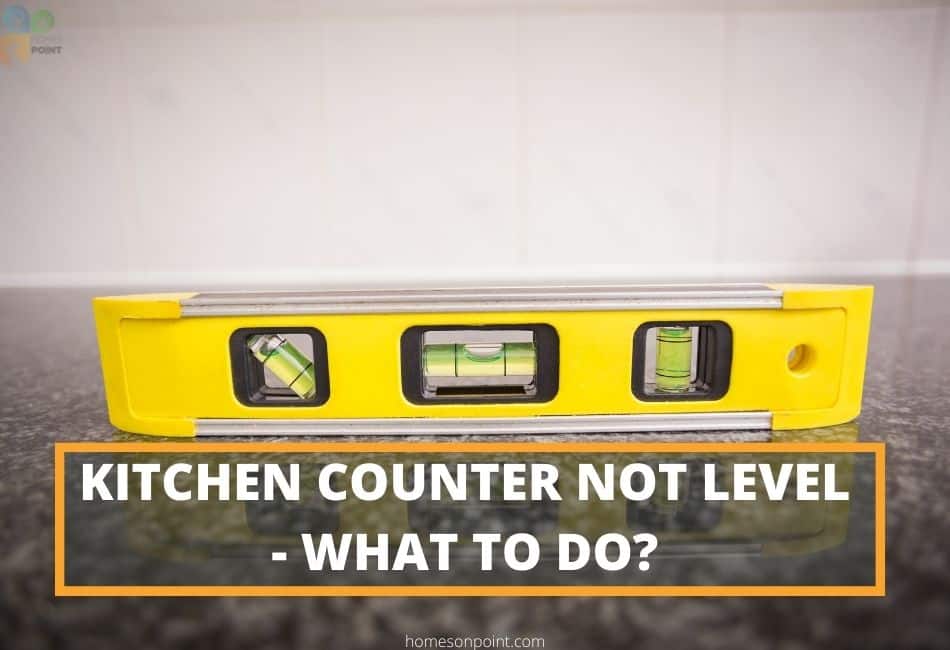Kitchen countertops are supposed to be level, but sometimes they’re not. Mostly when your kitchen counters are installed by a professional, they will be level. If for any reason they are not level, they make sure to fix it before they leave.
However, if you have installed your kitchen counters yourself or had someone else who isn’t a professional do it for you, there’s a chance they might not be level. If everything is properly set in place and you are just fixing the countertop, it is not a huge deal to make them level.
If you’ve ever tried to cook on a kitchen counter that’s not level, you know it can be a frustrating experience. Not only is it hard to get your ingredients evenly spread out, but it’s also tough to get your pots and pans to sit level on the surface. Even the simplest tasks, like chopping vegetables, can be a challenge when your counter isn’t level.
If you’re dealing with a kitchen counter that isn’t level, don’t worry – we have some tips for you. In this article, we’ll discuss the importance of having a level kitchen counter and what to do if yours isn’t quite right.
Why Should Kitchen Counters Be Level?
There are a few reasons why level kitchen counters are important.
1. Provide Stable Surface
First, they provide a stable surface for cooking. When counters are not level, it can be difficult to do many tasks in the kitchen. This is because most appliances and tools need to be stable to work properly. For example, if you’re trying to use a cutting board on an uneven surface, it’s likely that your knife will slip and slide, making it difficult to get a clean cut.
The same is true for many other kitchen tasks, like using a mixer or rolling out dough. Even something as simple as putting a pot of water on the stove can be difficult when your counter isn’t level. Not only will the pot wobble and spill, but it can also be a fire hazard.
2. Prevents Spillage
Another reason why level counters are important is that they help to prevent spillage. When liquids are spilled on an uneven surface, they tend to run off in different directions. This can not only make a mess, but it can also be dangerous.
For example, if you’re cooking with oil and it spills on an uneven counter, there’s a good chance that it will run off the edge and onto the floor. This can create a slip and fall hazard, and it can also be a fire risk.
Even something as simple as spilled milk can be a problem on an uneven counter. Milk is a slippery liquid, and it can easily run off the edge of a counter that’s not level. This can create a mess and attract bugs, so it’s important to keep your counters level to prevent spillage.
3. Distorts Appearance
Uneven counters can distort the appearance of your kitchen. When counters are not level, it can make your whole kitchen look unprofessional and unfinished. This is because level counters are one of the most basic elements of a well-designed kitchen.
If you’re trying to sell your home or simply want to make your kitchen look its best, level counters are a must. Uneven counters can be a turn-off for potential buyers and make your kitchen look less inviting.
4. Issues With Plumbing
Uneven counters can also cause problems with your plumbing. When counters are not level, it can put a strain on your pipes and fixtures. This can cause leaks and other problems down the line. When you have sinks built into your counters, it’s especially important to make sure they’re level.
If your counter isn’t level, there’s a good chance that your sink will also be uneven. This can cause water to pool in one area and not drain properly. The pipes connected to your sink can also be affected, and this can lead to leaks.
Common Causes Of Uneven Countertops
There are a few common causes of uneven countertops.
1. Setting
One of the most common causes is settling. As homes settle, the foundation can shift and cause the counters to become uneven. If the flooring wasn’t level, to begin with, this can also cause the counters to be uneven.
This is especially common in older homes, but it can happen in new homes as well. Settling is a gradual process, so you may not notice it right away.
2. Poor Installation
Another common cause of uneven countertops is poor installation. When counters are not installed properly, they can become uneven over time. This is why it’s important to hire a professional when you’re having new counters installed.
If you’re having your counters replaced, make sure the company you hire is experienced and has a good reputation. Otherwise, you could end up with counters that are not level.
3. Uneven Cabinets
Another most common cause of uneven countertops is uneven cabinets. If your cabinets are not level, it can cause your counters to be uneven. This is because the cabinets support the counters, so if they’re not level, the counters will also be uneven.
This is another reason why it’s important to hire a professional when you’re having new cabinets installed. If the cabinets are not installed properly, it can cause problems with the counters.
What To Do If Your Kitchen Counter Is Not Level?
If your kitchen counter is not level, there are a few things you can do to fix it. It doesn’t matter what your kitchen countertop material is made of, this method is universal.
One option is to shim the low side of the counter. This is a relatively easy fix, and it’s something you can do yourself. You’ll just need to find some shims that are the same thickness as the difference between the two sides of the counter.
Another option is to level the cabinets. This is a more difficult fix, and it’s something you should hire a professional to do. If the cabinets are not level, it can cause the counters to be uneven.
How To Use Shims To Level Your Kitchen Counter
Shims is a tempered hardwood or plastic wedges used to level and support objects. It’s commonly used in construction and renovation. This is one of the easiest ways to fix an uneven counter. If a particular section of your counter is lower than the rest, you can use wood shims to raise it.
Things Needed:
- Wooden shims
- Measuring tape
- Pencil
- Hammer
- Level
- Adhesive/screws
- Wooden saw
Procedure:
Step 1
First, you’ll need to find the low side and high side of the counter. You can do this by setting a level on the counter and seeing which side is lower. Make a pencil mark on the highest of the counter on the wall.
Then using the measuring tape, make a level line across the wall to the other side of the counter. This will be your reference line where the new countertop should reach.
Step 2
Next, you’ll need to determine how much shimming is necessary. This will depend on how far off the counter is from being level.
Step 3
Once you know how much shimming is necessary, you’ll need to find shims that will fit the space. You can find wood shims at most hardware stores. They come in a variety of thicknesses, so you should be able to find some that are the same thickness as the difference between the two sides of your counter.
Step 4
Once you have the shims, you’ll need to cut them to fit. The easiest way to do this is to use a wooden saw. Trim it very slightly so that it’s a snug fit. You don’t want it to be too loose or too tight.
Step 5
After you’ve cut the shims to size, it’s time to attach them to the counter. Hammer it in gently until it’s flush with the surface. To prevent the shims from slipping out of place use construction adhesive or screws. Just be sure that whatever you use is strong enough to hold the shims in place.
Step 6
Once the shims are in place, you should check to make sure the counter is level. If it’s not, you may need to add more shims. Once the counter is level, you can caulk the gaps between the shims and the counter. This will help to prevent water from getting under the counter and causing damage.
Hiring A Professional To Level Your Cabinets
If you decide to hire a professional to level your cabinets, there are a few things you need to keep in mind.
- First, you need to find a reputable company that has experience with cabinet installation.
- Second, you need to make sure that the company is insured and bonded. This will protect you in case of any damage that may occur during the installation process.
- Finally, you should get a written estimate from the company. This will help to avoid any surprises later on down the line.
Uneven kitchen counters are not a safety concern as much as it is an aesthetic one. However, if your counters are significantly uneven, it can make it difficult to use them properly. The above-discussed techniques can help you achieve a balanced countertop without the tedious work of leveling floors, leaving you with a beautiful level surface.
FAQs
Q: Is the countertop supposed to be level?
A: Absolutely! Uneven countertops can make it difficult to use them properly and can also be unsightly.
Q: How do you fix an uneven quartz countertop?
A: The best way to fix an uneven quartz countertop is to use shims. Shims are thin pieces of wood or plastic that you can use to raise a lower section of the countertop. You can find them at most hardware stores.
Q: Can I shim a countertop?
A: Yes, you can shim a countertop. That is one of the simple ways to fix an uneven countertop.
Q: How do you check if your cabinets are level?
A: The easiest way to check if your cabinets are level is to use a level. Place the level on the cabinet and see if it’s level from front to back and side to side. You can also use a tape measure to check for levelness. Measure the distance from the floor to the top of the cabinet on the left side, then measure the distance from the floor to the top of the cabinet on the right side. If the measurements are the same, then your cabinet is level. If they’re not, then they are not level.

